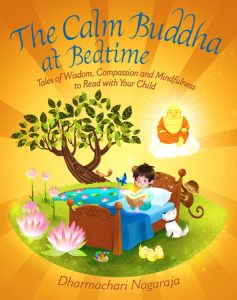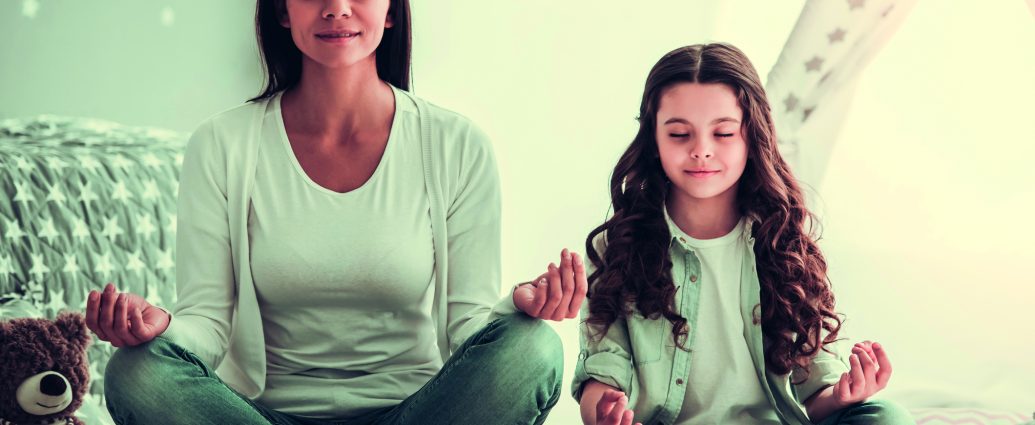Growing up in the modern world today many children are leading overstimulated and sometimes stressful lives. Worryingly, a key study by the Office of National Statistics found that one in ten children now suffer from mental health problems including stress, anxiety and depression. A much-needed antidote to help children let go of their anxieties and concerns at the end of each busy day could be found in ancient Buddhist tales with an emphasis on peace, calm and mindfulness…
What does being mindful mean?
Mindfulness is a quality of gentle attention that one can bring to our moment by moment experience in order to feel more engaged, fulfilled and calm. It is the ability to be open and present to what is actually happening, as we really are, whether we are walking, eating, playing, reading a story or even trying to get to sleep. For children this means encouraging them to let their attention settle on a single chosen object or activity and to become fully absorbed in it. You can be mindful about anything. As you go about your daily routine, encourage your child to focus fully on what’s happening – getting dressed, brushing their teeth etc.
Mindfulness meditations help children to develop more focus and self-awareness. The exercise on this page introduces children to the experience of paying attention to the breath, linking it with a powerful visual image of flowing, golden light. It’s a simple, quick practice that once they’ve tried can be helpful in everyday life, for example if they need to settle their mind and focus on a particular task. Before you start, ask your child to get into a comfortable, cosy position. Then gently read the following words out loud to them:
Notice how you are feeling.
Take a long, slow deep breath in through your nose.
And then a long, slow breath out through your mouth.
Repeat.
Let your body soften and feel nice and cosy.
Now, imagine that your breath is a beautiful, soft, golden light.
Make your next breaths long and gentle,
Imagine your body is filling with soft, golden light
With each new golden breath
From right up at the top of your head,
Flowing down,
Out along your arms to your hands,
Gentle, golden light flowing to the tips of your fingers.
As you continue to breathe,
Imagine yourself feeling cosier and cosier.
Feel the golden light flow down your back,
Fill and relax your chest,
And then fill and soften your tummy,
Before moving down into your legs,
Into your feet,
Then filling each of your toes.
As the golden light flows through you,
You feel more and more relaxed.
If you get distracted,
Just notice your body again,
Notice your breath
And imagine the golden light
Filling you with warmth and ease.
Finally, as you breathe out,
Let the golden light flow out of your mouth
into the air around you.
Notice how you are feeling now.
Well done!”
Meditation Tips: Finding the right time and place
With any new skill we want to develop, repetition is the key. Try to practise meditation with your child at the same time each day and in the same place. The regularity and quality of the meditation are more important than the length of time you spend doing it. Stopping for even five minutes a day to rest and take the mind away from day-to-day concerns often has calming effects that ripple on far longer than you might expect. And the more often you practise, the farther the ripples will spread. If possible, find somewhere where both you and your child feel warm, comfortable and safe – somewhere that is quiet and when reading the meditations to your child, take your time and allow for pauses so that they have time to really imagine and experience the scenes that you are describing. These are also useful tools in aiding rest and bringing about sleep. It is the mind’s nature to wander, so don’t worry if your child becomes distracted at times when doing a visualisation. It’s completely normal. Simply, gently and kindly bring their attention back to the sensation.
Mindfulness at bedtime
If you’re using the techniques at bedtime your child is likely to be in their nightclothes – which are perfect so long as they’re warm enough – but don’t forget that your own clothes should be comfortable too. Your posture helps to support and encourage the experience you want to create for your child, so aim to sit in a way that reflects an alert but relaxed and comfortable state of mind. Do the meditations snuggled up cosily in bed, or sat on a chair or on the floor however your child might enjoy them most lying down. See what works best for both of you.
As children grow and face new challenges, mindfulness will remain a skill that can help them build their confidence, cope with stress calmly and constructively, and cultivate increased inner wisdom. Being more mindful also involves learning to be non-judgemental and compassionate toward whatever arises in our moment-to-moment experience. This kind attitude is the foundation of emotional intelligence, healthy social relationships and sound mental health throughout life.

Extracts taken from The Calm Buddha at Bedtime, available at Amazon priced £12.99
Calm Buddha at Bedtime is a charming, fun and beautifully illustrated collection of 18 traditional Buddhist bedtime stories, the third in the hugely popular Buddha at Bedtime series of books which have sold over 200,000 copies worldwide. The compelling narratives help to focus and calm the mind, providing a smooth transition into sleep and the additional selection of gentle mindfulness meditations provide an extra practical dimension that can be used any time to help enhance a sense of calm and contentment.

About the author
Dharmachari Nagaraja has been a practising Buddhist for over 20 years. Formerly, he was head of the Covent Garden Meditation Centre in London and a regular presenter on BBC Radio 2’s Pause for Thought with Terry Wogan. He now lives in Glasgow where he works as a Psychosynthesis Psychotherapist and teaches counselling at the University of Glasgow.

